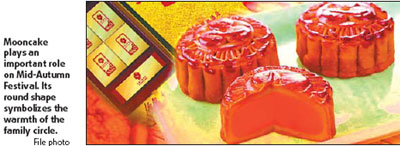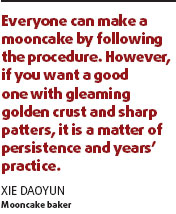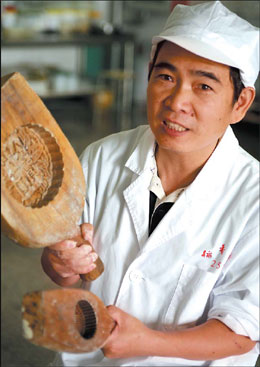Let them eat cake
Xie Daoyun feels very proud about making China's biggest ever mooncake. Last month, the Anhui native, along with nine other master mooncake-makers, set the new record at the First China Food Bakery Festival in Shenyang, the capital of Northeast China's Liaoning Province.
Each master specialized in a particular style of mooncake: Cantonese style, Suzhou style and Hong Kong style for instance. Xie is recognized as the Beijing-style expert.

The gigantic 8.15-meter in diameter, 25,000-kilogram dessert was divided into 10 different sections so all participants could put their talents to good use. Xie and other people even climbed up a trestle hanging on the top of the mooncake, and acted like acrobats to stuff the middle bit by bit without destroying the cake's shape. He then remained alert beside an oven until 3 am when it was successfully baked.
The mooncake would be distributed to hundreds of people in the city before the Mid-Autumn Festival.
Xie has already returned to Beijing and had no chance to try a piece. You can't have your cake and eat it too, however, Xie is not disappointed and says the record-breaking experience is enough to make him happy.
The 37-year-old looks too young to hold the "master" mooncake making title and is camera shy when surrounded by media. But the researcher at the Beijing Daoxiangcun Foodstuff Group oozes confidence and his hands work wonders when he gets to work.
Xie came to Beijing as a migrant worker in 1991 to try his luck. He had zero experience in cooking.
"I didn't look for a particular job at that time. As long as I could get employed, I would be happy with it," he recalls.
With the help of his relatives, Xie was introduced to Daoxiangcun, a household brand in Beijing for traditional food, and took the job of mooncake making for the upcoming Mid-Autumn Festival.

He was delighted his floating life had come to an end, but what he didn't know was that the small piece of dessert would take him places he had never imagined before.
The history of the traditional mooncake pastry can be traced back to Tang Dynasty (AD 618-907), and it was made to celebrate a Tang army victory over the Huns, an ancient ethnic group in the north of China.
Mooncakes began to become popular in the Ming Dynasty (1368-1644), when bakers stamped a pattern of a fairy tale on top. The tale involved a goddess who flew to the moon after taking the elixir from her husband. The cakes became a must-try pastry during Mid-Autumn Festival, 15th of the eighth lunar month.
The festival is now a family affair and the mooncake's round shape symbolizes the warmth of the family circle.
The leading type among those mooncakes is Cantonese-style ones, which account for about half of all mooncakes sold nationwide. These tasty treats feature soft crusts and fillings made by red beans or jujube pastes, plus one or several salted yolks inside.
The Beijing-style cake has a smaller size and much harder wrapping, with stuffing of persevered pulp pieces and sugar.
The number of Cantonese-style mooncakes Xie has made is far more than the Beijing types.
"Everyone can make a mooncake by following the procedure," he says. "However, if you want a good one with gleaming golden crust and sharp patters, it is a matter of persistence and years' practice."
Some mooncakes collapse when baked in an oven if a baker fails to prepare it properly, and even a small step of brushing the crust with egg yolks requires high skills, which otherwise will lead it to be either burnt or less brightened, Xie explains.
Every baker should taste whatever he makes, however, it will probably ruin any chance of enjoying mooncakes again.
|
Xie Daoyun shows two wooden molds used to make mooncakes. The 37-year-old is one of the best mooncake bakers in the country.Photos by Lu Zhongqiu |
"I used to love eating mooncakes so much. But I no longer have an interest in them now," he says. "I don't have any choice but to keep eating to make sure it gets good taste."
Most Daoxiangcun mooncakes are made by machine and only a few kinds are made by hand, including some special orders with gigantic size.
Xie is the only Daoxiangcun baker capable of hand-making patterns requested by customers. Dragons, phoenixes, flowers and even Fuwa mascots of the 2008 Beijing Olympic Games are all popular.
When people were amazed by the life-like pattern on the mooncake, only Xie understood how much hard work was involved under the elegant surface.
"I am a migrant worker without either a higher education background or being well-trained in food production," he says. "The only way to success is hard work and learning things by heart."
Xie has been recently promoted to the research department to come up with new styles of the dessert. "Mooncake contains a great deal of sugar and oil. What I am trying to do is finding healthier ingredients to replace them," he says.
Various mooncakes with fruit flavors have been developed - papaya and lotus roots for instance, and even green tea.
Xie personally believes, no matter how many new styles will be developed in the future, "the traditional ones with kernel-stuffing are always the best and last forever".
(China Daily 09/25/2007 page19)















